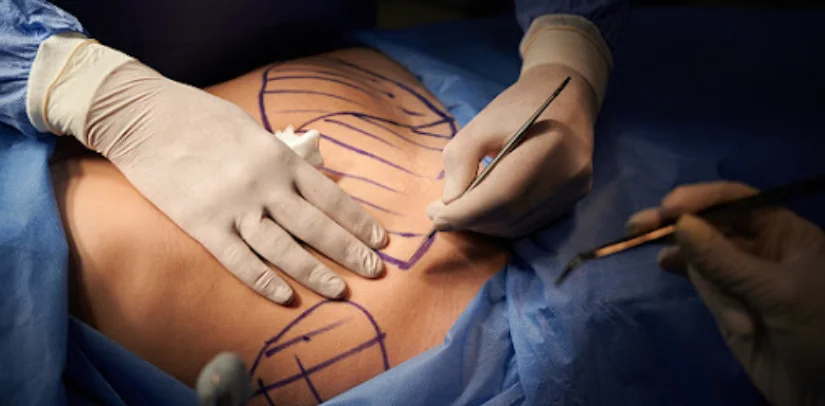Tummy Tuck Treatment Have Improved Over The Decades
An abdominoplasty may be the ideal operation for you if you want a "mommy makeover" or merely want to
improve the profile of your abdomen. In a tummy tuck, extra skin and fat are removed from the area around
the abdomen, and the underlying muscles are tightened. In recent decades, the tummy tuck has become one of
the most popular cosmetic procedures. Continue reading to learn how tummy tuck techniques and outcomes have
evolved and improved over time.
Explore How Tummy Tuck Treatment Have Improved Over The Decades
Tummy tuck surgery (abdominoplasty) is a cosmetic operation that treats abdominal aesthetic issues. Many
men and women battle with excess fat and sagging skin in their bellies due to age, lifestyle, or life events
(pregnancy or weight loss). It will then employ internal sutures to tighten the underlying abdominal muscles,
surgically remove any excess skin around the abdomen, and draw the remaining skin tight before closing the
wounds. After the tummy tuck recovery phase, you can expect a better-contoured body appearance that will
make you feel more confident in your appearance.
Benefits of Tummy Tuck
Aside from the cosmetic benefits of a stomach tuck, there are several other advantages that some patients
may not be aware of before their consultation. A belly tuck lowers one's BMI and can put you in the healthy
range. Tummy tucks tighten your abdominal muscles, which has the additional benefit of repairing a weaker
core, reinforcing abdominal muscles, and improving general abdominal flexibility. This can help to reduce
lower back discomfort and improve posture. Increasing your control over bodily functions such as stress
incontinence, ventral hernias, and bowel function loss are all possible side effects of pregnancy, ageing,
or being overweight.
How Tummy Tucks Have Improved Over the Decades
In recent decades, the tummy tuck has become a popular cosmetic procedure for those who want to maintain
a slim figure. The treatment often entails an incision from one side of your hip to the other to remove excess
skin and fat from the middle and lower abdomen, depending on the type of tummy tuck. This, in turn, contracts
the abdominal wall muscle and tissue, necessitating extensive rest. But did you realise that this practice
dates back to the early 1800s and how they were performed?
Tummy Tucks and the Belly Button in the Early 1800s
Although the first stomach tucks were performed more than 200 years ago, they were not performed for the same
reasons that they are now. In the early 1800s, the major objective of this treatment was to remove superfluous
skin from the abdomen area to cover up exposed wounds. As a result, the early stomach tucks frequently left
patients without a belly button.
Early 20th Century: Significant Advances in Tummy Tuck Procedures
In 1905, plastic surgeons finally figured out how to maintain the belly button during a stomach tuck after
nearly 100 years. They discovered that instead of making horizontal incisions across the entire belly, they
might employ vertical and horizontal incisions to generate little flaps. The belly button was kept in this
manner, and the results were smoother than ever before. Doctors didn't start employing tummy tuck treatments
to address umbilical hernias until the 1970s and 1980s. Surgeons quickly learned that a tummy tuck could give
a smoother, tighter appearance, paving the way for today's tummy tuck procedures.
Mini Tummy Tuck
Before the introduction of the little tummy tuck in plastic surgery, any patient wishing to treat any degree
of sagging abdominal skin had to undergo a full stomach tuck. Plastic surgeons may now tighten a small amount of
excess skin below the belly button using a far smaller incision thanks to the micro tummy tuck method, often
known as a partial abdominoplasty.
Mommy Makeovers with a Tummy Tuck
Tummy tucks are now frequently combined with additional cosmetic operations such as breast augmentation
or liposuction to form what is known as a mommy makeover.
The Drain-Free Tummy Tuck
Before the invention of this procedure, all tummy tucks used a drain to avoid internal fluid buildup during
and after surgery. By eliminating the necessity for a drain, it has also eliminated the difficulties that
resulted from patients having to empty the contents of their drain regularly before removal.
The Extended Tummy Tuck
This treatment, designed for obese individuals with a substantial quantity of excess fat and overhanging skin,
develops a new belly button and tightens the abdominal muscles.
The Circumferential Tummy Tuck
The patient's outer thighs and buttocks are additionally elevated in this entire treatment to tighten all key
muscles and create a contoured body shape. This is designed for patients who have lost a substantial amount of
weight and fat, typically following gastric bypass surgery and are now struggling with extra skin in several
locations of the lower body.
What is the most appropriate tummy tuck treatment for you?
Modern surgical devices and procedures have made tummy tucks more accessible than ever before. You can now
customise your stomach tuck procedure to your specific desires and goals. Your natural anatomy, personal
consultation and assessment, and your aesthetic goals will all play a role in determining the optimal stomach
tuck approach for you.
Get Desired Body Appearance with Tummy Tuck Treatment From Sushrutha Cosmetics
It is essential to prioritise safety, quality of service, and certification when selecting a healthcare
centre for plastic and cosmetic surgery. At Sushruta Plastic & Cosmetic Surgery Centre, we recognise the
necessity of offering complete care without sacrificing these critical features. We put your comfort and
safety first. To assure the greatest level of treatment, our hospital is outfitted with cutting-edge equipment
and state-of-the-art surgery suites. We follow strong infection control policies and best practices to ensure
a clean and sterile atmosphere for your treatment.


















